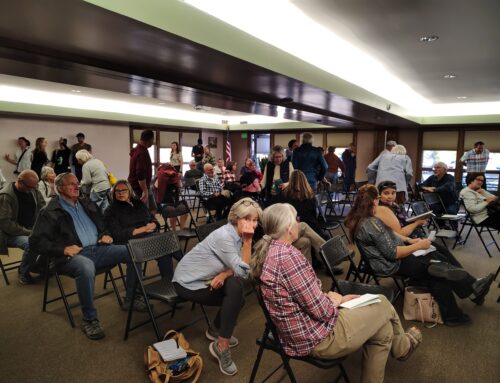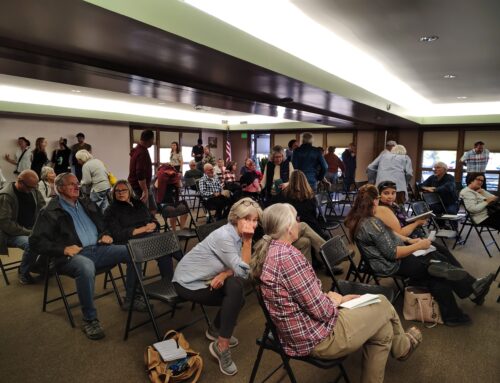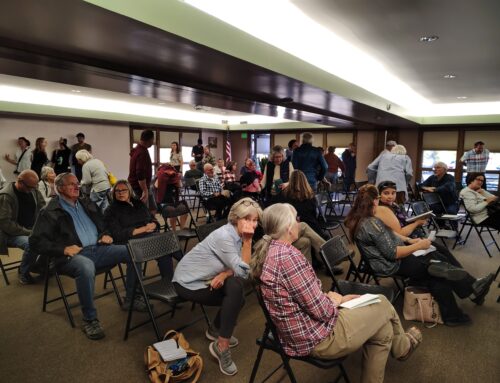Amazon Answers Community Questions About Proposed Facility – by Carly Winchell
October 28, 2025

Sam Bailey delivers a presentation about Amazon’s proposed delivery station in BV. Photo by Carly Winchell.
Amazon has a vision for a distribution center in Buena Vista (BV). Amazon Senior Manager of Economic Development Sam Bailey presented that vision to the community last week to a room of interested residents. Bailey is the lead for all Amazon development projects in Colorado.
The presentation was the same one Bailey presented to BV trustees a week before the community engagement event. The proposal itself is for a “last-mile” delivery station in BV.
This would not be a warehouse full of goods waiting to be ordered. The station would receive one to two semi trucks of Amazon packages per day. Those packages would then be sorted into delivery vehicles, which take them to customers.

The crowd grew over the course of the event. Bailey presented general information each hour to inform new attendees before launching back into questions and answers. Photo by Carly Winchell.
The proposed location is a 10-acre section of land; what was previously known as Topside. This is located north of the prison, and south of Antero Circle along Railroad.
Amazon intends to purchase 10 acres of the 30-acre Topside parcel for the delivery station. Bailey said it has no intention to purchase the other 20 acres. The property will need to be subdivided through the county, then annexed into BV, and rezoned as light industrial.
Bailey said the facility would start with 17 delivery vans, additional flex drivers, and 25 full- and part-time employees in the station.
Full-time employees would make around $30 an hour (this amount includes benefits) to start.
“The whole goal is to be able to deliver for our customers in two days or less, leveraging the fulfillment center network in the front range,” said Bailey.
“Our challenge right now is that that service is not equitable across the entire state, so the goal is to take ownership of our own customer capacity and to be able to deliver to our customers using new delivery stations.”
Deliveries through the BV station would service areas within a 60-minute drive. This could include Leadville, Salida, Fairplay, and even Conifer.
The 25 employees would be eligible for healthcare and a 401(k) on their first day, and Career Choice (education assistance) after 90 days.
Delivery drivers would be 1099 contract employees through a “Delivery Service Partner.” As a separate entity, Delivery Service Partners could offer their own benefits. Flex drivers are also contract.
Questions from the audience primarily focused on reasoning for the location, traffic impacts, and possible future expansion.
Bailey said the location was selected due to customer demand in the area. He added that they had considered other properties, but this was the first choice because it allowed vehicles to get off the highway faster, reducing congestion.
Bailey added that traffic for the facility would be predictable and consistent. One-t0-two semis would arrive in the early morning (between 2:00 a.m. and 5:00 a.m.). Vans would then have a staggered departure between 9:30 a.m. and 10:30 a.m. The last dispatch would go out around 11:30 a.m.
The facility itself would be overbuilt to leave room for expansion. It has more parking spaces than necessary at the start, specifically to allow for growth.
When questioned, Bailey said the company had no interest in the other 20 acres of the parcel. Any future projects on those parcels would be up to the seller and whoever was interested in buying it. Audience members voiced concerns about the precedent that rezoning to light industrial would set for the area.
Amazon will not go through with the purchase until the property is subdivided and a pre-annexation agreement is reached.
While Amazon does operate a large fleet of electric vehicles, they would not be deploying electric vehicles in BV, at least at first.
“We operate the largest private electric fleet in the state of Colorado,” said Bailey. Amazon also launched a hybrid model fleet at its delivery station in Gypsum. But in this area, the fleet would be gas-powered, leading some attendees to express concerns.
“The [all-electric] vans that we utilize in the metro Denver area have a range of about 160 miles. That gets eaten up a little bit more out here with mountains and roads. . . We’ll start out with just a normal RAM or core transit van, and then based on that, we’ll integrate probably an all-wheel drive hybrid model,” said Bailey in response to a question about the vehicles.
Property taxes on the facility would go to BV if it were annexed successfully.
Bailey also said Amazon expected to pay “full freight” for its facility and any associated infrastructure improvements, such as road improvements due to increased traffic.
“We’re going to be asked to make improvements along this road that we will have to pay for, which include things like curb cuts, accel-decel striping to accommodate one or two line haul trucks.”
When asked why Amazon intended to annex into the town, Bailey replied, “We want to get the right site and also have a good relationship with the community. By being annexed into the town of Buena Vista, the town gets to tell us we have to do certain things. They have jurisdiction. . . There’s a partnership, and they get to hold us accountable to operational standards, operational complaints, the town administrator gets to pick up the phone and call my cell phone and say, ‘I’m not happy with Amazon, here’s why,’ or, ‘Things are going well, you’re in compliance.’”
One audience member asked about a recent article on Amazon’s automation efforts.
“There was an article this morning in the New York Times about Amazon planning to automate 75 percent of its operations. This is attributed to internal documents, and that would mean robots replacing more than half a million jobs across the country,” she said. “How would that plan impact this facility? So you hire away all the people from the businesses here, they go out of business, and then you automate?”
Bailey said he couldn’t speak to “hearsay” in the article. “We are focused on implementing further integration of our robotic system in our fulfillment centers. This project is not a fulfillment center. It’s a delivery station. . . So until autonomous vehicles are delivering and throwing your package on your doorstep, which we’re not doing that, we would continue to employ people here.”
Speaking of “autonomous” delivery, Bailey said Amazon would not be deploying drone delivery in the BV area. He said drones were utilized in larger cities and not at elevation.
In response to questions about whether they would be able to attract and retain enough employees, Bailey said that it was Amazon’s responsibility to be a good place to work.
“In terms of working conditions, we strive to be the earth’s best employer,” said Bailey. “That’s why we provide competitive wages, health care benefits, upskilling when they start working for us, and the goal that we can retain them to work for us. So if someone needs to go to the bathroom, they can go to the bathroom. If they need to take a break, they can take a break.”
“I’ve had this question asked by governors, senators, you name it. We wouldn’t be able to have 20,000 people working for us if we were not a good steward to our employees. And there are articles, there are social media reels about all of these sensational items… I will tell you that if you walk around our sites, they’re the cleanest, most accessible sites, and we strive to be a great employer.”
It is notable that, in 2024, a Senate probe found that Amazon manipulated workplace injury data.
NPR’s Juliana Kim wrote, “It concluded that Amazon workers were put in harm’s way by being forced to work at ‘an extremely fast and often dangerous pace.’ Although the company has safety protocols, the report said ‘the company’s required rates make those procedures nearly impossible to follow.’”
The company rejected those findings.
The Guardian’s Michael Sainato reported, in 2022 and 2023, OSHA (Occupational Safety and Health Administration) issued citations against Amazon at six warehouses. A seventh in Colorado Springs was cited in February 2023. OSHA and Amazon reached a settlement in December 2024.
Search
RECENT PRESS RELEASES
Related Post





